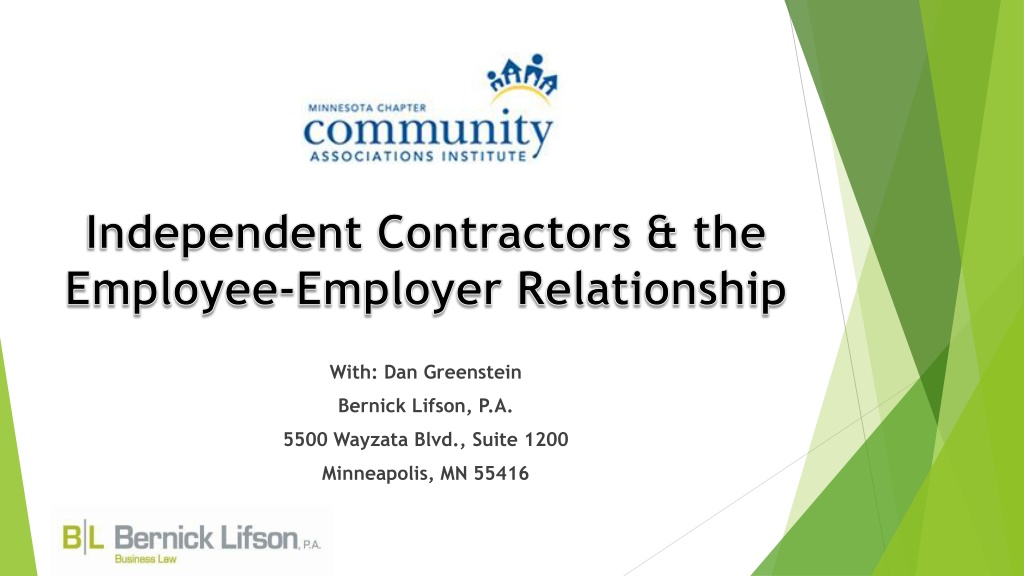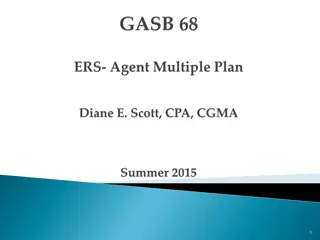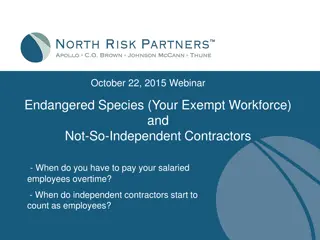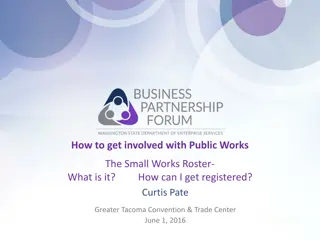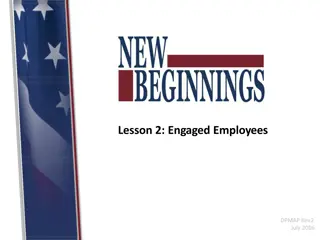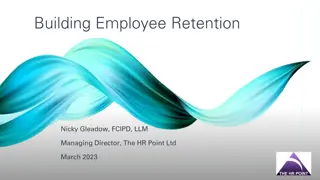Understanding Independent Contractors and the Employee-Employer Relationship
Explore the distinctions between independent contractors and employees, the importance of defining each correctly, and key considerations for HOA leaders. Learn about common definitions, how different laws define independent contractors, and the characteristics of an employee as per Minnesota statutes.
Download Presentation

Please find below an Image/Link to download the presentation.
The content on the website is provided AS IS for your information and personal use only. It may not be sold, licensed, or shared on other websites without obtaining consent from the author. Download presentation by click this link. If you encounter any issues during the download, it is possible that the publisher has removed the file from their server.
E N D
Presentation Transcript
Independent Contractors & the Employee-Employer Relationship With: Dan Greenstein Bernick Lifson, P.A. 5500 Wayzata Blvd., Suite 1200 Minneapolis, MN 55416
Overview 1) What s the Difference? 2) Why does it Matter? 3) Considerations for HOA Leaders 4) Can you just use a handy man or woman?
Whats an Independent Contractor?
Independent Contractor Common Definitions A frequently stated definition of the term independent contractor is one who, in exercising an independent employment, contracts to do certain work according to his or her own methods, without being subject to the control of the employer, except as to the product or result of the work 1 An independent contractor is a person who contracts with another to do something for him, but who is not controlled by the other or subject to the other's right to control with respect to his physical conduct in the performance of the undertaking. 2 1 41 Am. Jur. 2d Independent Contractors 1 2 Restatement 2d, Agency 2(3). See also Lindbery v. J. A. Danens & Son, Inc., 266 Minn. 420, 422, 123 N.W.2d 695 (Minn. 1963) (explaining that Minnesota looks to the Restatement of Agency 220).
Independent Contractor Not Easy to Define No simple definition exists because many Federal and State Laws define the term Independent Contractor differently In other words, each law uses a different test Examples: I.R.S. 20-Factor Test Fair Labor & Standards Act (FLSA) - Economic Realities (5-Factor) Test National Labor Relations Act & ERISA - Right to Control Test Title VII 16+ Factor Test
Employee Defined The term employee is defined as any person who performs services for another for hire. Minn. Stat. 176.011. However, covered employment does not apply to persons who are independent contractors as defined by rules adopted by the commissioner pursuant to section 176.83. Minn. Stat. 176.041.1 an employee is normally defined as a person in the service of another under a contract of hire, which may be express, implied, oral, or written, and which gives the employer the right to control and direct the person in the material details of how the work is to be performed. 2 1 1-1 Littler on Minnesota Employment Law 1.1. 2 27 Am. Jur. 2d Employment Relationship 2
Employee Definition It Depends Depending on the situation, the definition for employee may change: Taxes 20-Factor Test I.R.S. MN Dept. of Revenue Wages & Overtime Economic Realities (5- Factor) Test Fair Labor & Standards Act (FLSA) Minnesota Fair Labor Standards Act MN Workers Compensation Unions & Benefits - Right to Control Test National Labor Relations Act ERISA MN Income Taxes (most important factor) Discrimination 16+ Factor Test Title VII
I.R.S. 20 Factors 1. Instructions. Workers who are required to comply with others instructions about when, where, and how they are to work are ordinarily employees. 2. Training. Training workers indicates that employers exercise control over the means by which results are accomplished. 3. Integration. When the success or continuation of a business depends on the performance of certain services, the workers performing those services are subject to a certain amount of control by the owners of the businesses. 4. Services rendered personally. If services must be rendered personally, employers control both the means and the results of the work. 5. Hiring, supervising, and paying assistants. Control is exercised if employers hire, supervise, and pay assistants.
I.R.S. 20 Factors (contd) 6. Continuing relationships. Continuing relationships between workers and employers indicate that employer-employee relationships exist. 7. Set hours of work. The establishment of set hours of work by employers indicates control. 8. Full-time required. If workers must devote full time to employers businesses, employers have control over workers time. Independent contractors are free to work when and for whom they choose. 9. Doing work on employers premises. Control is indicated if the work is performed on employers premises. 10. Order or sequences set. Control is indicated if workers are not free to choose their own patterns of work but must perform services in the sequences set by the employers.
I.R.S. 20 Factors (contd) 11. Oral or written reports. Control is indicated if workers must submit regular oral or written reports to employers. 12. Payment by hour, week, or month. This points to employer-employee relationships, provided that this method of payment is not just a convenient way of paying a lump sum agreed on as the cost of a job. Independent contractors are usually paid by the job or on straight commission. 13. Payment of business and/or traveling expense. Employers paying workers expenses of this nature shows that employer-employee relationships usually exist. 14. Furnishing tools and materials. If employers furnish significant tools, materials, and other equipment, employer-employee relationships usually exist. 15. Significant investments. Workers are independent contractors if they invest in facilities that are not typically maintained by employees (such as an office rented at fair market value from an unrelated party). Employees depend on employers for such facilities.
I.R.S. 20 Factors (contd) 16. Realization of profits or losses. Workers who can realize profits or losses (in addition to profits or losses ordinarily realized by employees) they are independent contractors. Workers who cannot are generally employees. 17. Working for more than one firm at a time. If workers perform services for a number of unrelated persons at the same time, they are usually independent contractors. 18. Making services available to the general public. Workers are usually independent contractors if they make their services available to the general public on a regular and consistent basis. 19. Right to discharge. The right of employers to discharge workers indicates that the workers are employees. 20. Right to terminate. Workers are employees if they have the right to end their relationships with their principals at any time without incurring liability.
Comparison Independent Contractor Generally, an independent contractor is someone with a special skill (and with the bargaining negotiate a rate for the use of that skill), who serves multiple clients, performing discrete tasks for limited periods, while discretion over the way the work is actually done. 1 Employee Generally, an employee is someone who works under the direction of a supervisor, for an indefinite period of time, with fairly regular hours, receiving most or all his income from that one employer. 1 power to extended or exercising great 1 41 Am. Jur. 2d Independent Contractors 1 (citing Cotter v. Lyft, Inc., 60 F. Supp. 3d 1067 (N.D. Cal. 2015)).
The Label Doesnt Matter the nature of the relationship of the parties is to be determined from the consequences which the law attaches to their arrangements and conduct rather than the label they might place upon it. Speaks, Inc. v. Jensen, 243 N.W.2d 142, 145 (1976) Key Takeaway: The relationship not the label determines whether someone is an Independent Contractor or an Employee.
Liability Generally, an employer of an independent contractor is not liable for physical harm caused to another by an act or omission of the contractor or [their employee]. 1 Employers are not required to purchase workers compensation insurance for Independent Contractors.2 1Anderson v. Dep t of Nat. Res., 693 N.W.2d 181, 189 (Minn. 2005) 2 MINN. STAT. 176.041(12)
Compensation Employees are entitled to: Minimum Wage Overtime (1.5x) FMLA leave But not, Independent Contractors
Employee Withholdings examples: Federal Insurance Contributions Act (FICA) Medicare Social Security Federal Unemployment Tax (FUTA) State Unemployment Tax (SUTA) And Misclassification can be expensive because the I.R.S. can hold you responsible for the unpaid employment tax liability
Jack and Carries Construction Jack s Construction is building a house. Jack s Construction is not licensed to do the electrical work. Carrie s Electric is subcontracted to do the work. Carrie bids the job and will be paid upon completion. The work is done independently, but Carrie must follow all specifications of Jack. Carrie advertises her business in the telephone book and newspaper. She uses her own tools and equipment and works with many construction companies.
Is Carrie an: Independent Contractor or Employee ?
Donna the Property Manager Donna is a property manager who works full-time and is paid bi-weekly by All-In Management. Donna s job is to manage Blue Ridge HOA. Donna works 5 days a week and is on duty in Blue Ridge s office on certain assigned days and times. Donna is required to take direction from the Board. Donna also has various job responsibilities such as staffing the office, advising the Board, writing collection letters, delivery of packages, answering questions for owners. Because of her experience, she requires only minimal assistance in her work. She is paid a salary with a possibility of a bonus. Donna receives health insurance and group- term life insurance. What if Donna worked directly for Blue Ridge HOA?
Is Donna an: Independent Contractor or Employee ?
Who is Donnas Employer? Blue Ridge HOA or Property Management Company
Redwood Sensory Lab Redwood is a sensory laboratory that specializes in odor testing of materials, products and air for private industry and the government. The company hires sensoryassessors who perform odor evaluations and record their observations so that Redwood can relay the test results to its customers. A sensory assessor sniffs a product or air sample and records his or her observations on a questionnaire, which is tallied and compiled into an odor evaluation. The sensory assessors sign up for whichever tests they want to participate in. They do the testing in whatever manner they choose, receive a lump sum for each assessment session rather than hourly pay, and are free to read the paper, play cards, knit, or just visit with the other assessors for about 50 minutes per hour during an assessment session. Believe it or not, this is actually a real case decided by the Minnesota Court of Appeals in 2010. St. Croix Sensory Inc. v. Dep t of Emp t & Econ. Dev., 785 N.W.2d 796 (Minn. Ct. App. 2010).
Are the Sensory Assessors: Independent Contractors or Employees ?
Creekview Association Creekview is a large HOA with 140 Units. It needs a handyman. One of the directors friends named Fred is a great handyman who recently retired but changed his mind and he is looking for work again. He has his own tools, truck and skills. He doesn t need supervision. The board and Fred reach an agreement where Fred will work 25 hours a week at $25/hour and get health insurance. Fred will be on call if an urgent fix is needed. Fred believes he is an independent contractor. Is he?
Is Fred an: Independent Contractor or Employee ?
Hire a Handyman? MINN. STAT. 326B.805 Licensing Requirements. Subdivision 1. Persons required to be licensed. A person who meets the definition of a residential building contractor as defined in section 326B.802, subdivision 11, must be licensed as a residential building contractor by the commissioner. A person who meets the definition of a residential remodeler as defined in section 326B.802, subdivision 12, must be licensed by the commissioner as a residential remodeler or residential building contractor. A person who meets the definition of a residential roofer as defined in section 326B.802, subdivision 14, must be licensed by the commissioner as a residential roofer, residential building contractor, or residential remodeler.
MINN. STAT. 326B.802 Definitions. Subdivision 11. Residential building contractor. Subdivision 12. Residential remodeler. Subdivision 14. Residential roofer. "Residential building contractor" means a person in the business of building residential real estate, or of contracting or offering to contract with an owner to build residential real providing two or more special skills as defined in this section. A residential building contractor may also contract or offer to contract with an owner to improve existing residential real estate. "Residential remodeler" means a person in the contracting or contract with an owner to improve existing residential real estate by providing two or more special skills as defined in this section. "Residential roofer" means a person in the contracting, or contract with an owner, to complete work on residential real estate in roof coverings, roof sheathing, roof weatherproofing and insulation, and repair of roof systems, but not construction of new roof systems. business offering of to business offering of to estate, by
MINN. STAT. 326B.805 Subdivision 6. Licensing Requirements Exemptions. The license requirement does not apply to: (1) . . . ; (2) an owner of residential real estate who builds or improves any structure on residential real estate, if the work is performed by the owner's bona fide employees or by individual owners personally. (3) This exemption does not apply to an owner who constructs or improves property for purposes of speculation if the building or improving is performed by the owner's bona fide employees or by individual owners personally. A residential building contractor or residential remodeler will be presumed to be building or improving for purposes of speculation if the contractor or remodeler constructs or improves more than one property within any 24- month period; (4) . . . ;
MINN. STAT. 326B.805 Subdivision 6. Licensing Requirements Exemptions. (continued) (5) a person whose total gross annual receipts for performing work for which licensure would be required under this section do not exceed $15,000; (6) a mechanical contractor; (7) a plumber, electrician, or other person whose profession is otherwise subject to statewide licensing, when engaged in the activity which is the subject of that licensure; (8) specialty contractors who provide only one special skill as defined in section 326B.802; (9) . . . .; and (10). . . . To qualify for the exemption in clause (5), a person must obtain a certificate of exemption from licensure from the commissioner. A certificate of exemption will be issued upon the applicant's filing with the commissioner, an affidavit stating that the applicant does not expect to exceed $15,000 in gross annual receipts derived from performing services which require licensure under this section during the calendar year in which the affidavit is received. For the purposes of calculating fees under section 326B.092, a certificate of exemption is an entry level license. To renew the exemption in clause (5), the applicant must file an affidavit stating that the applicant did not exceed $15,000 in gross annual receipts during the past calendar year. If a person, operating under the exemption in clause (5), exceeds $15,000 in gross receipts during any calendar year, the person must immediately surrender the certificate of exemption and apply for the appropriate license. The person must remain licensed until such time as the person's gross annual receipts during a calendar year fall below $15,000. The person may then apply for an exemption for the next calendar year.
Minn. Stat. 326B.802 Definitions. Subdivision 15. Special Skills Special skill" means one of the following eight categories:
Excavation. Excavation includes work in any of the following areas: excavation trenching grading site grading
Masonry and concrete.Masonry and concrete includes work in any of the following areas: drain systems poured walls slabs and poured-in-place footings masonry walls masonry fireplaces masonry veneer water resistance and waterproofing
Carpentry. Carpentry includes work in any of the following areas: rough framing finish carpentry doors, windows, and skylights porches and decks, excluding footings wood foundations drywall installation, excluding taping and finishing.
Interior finishing. Interior finishing includes work in any of the following areas: floor covering wood floors cabinet and counter top installation insulation and vapor barriers interior or exterior painting ceramic, marble, and quarry tile ornamental guardrail and installation of prefabricated stairs wallpapering
Exterior finishing. Exterior finishing includes work in any of the following areas: siding soffit, fascia, and trim exterior plaster and stucco painting rain carrying systems, including gutters and down spouts
Drywall and plaster. Drywall and plaster includes work in any of the following areas: installation taping finishing interior plaster painting wallpapering
Residential roofing. Residential roofing includes work in any of the following areas: roof coverings roof sheathing roof weatherproofing and insulation repair of roof support system, but not construction of new roof support system
General installation specialties. Installation includes work in any of the following areas: garage doors and openers pools, spas, and hot tubs fireplaces and wood stoves asphalt paving and seal coating ornamental guardrail and prefabricated stairs
What does this Mean? A handyman who performs a variety of tasks (more than one)for the HOA, must be licensed unless an exemption (such as the $15,000/year exemption) applies.
Property ManagerHOA or Management Company Will the manager be an independent contractor or an employee? Should the manager be employed by the HOA or the Management Company?
Considerations HOA Need to do payroll, tax filing and need to withhold for: Need to provide training Need to have defined benefits and leave Federal Insurance Contributions Act (FICA) Need to have human resource training Medicare Employment Contracts Social Security Replacing terminated employees Federal Unemployment Tax (FUTA) State Unemployment Tax (SUTA) Insurance
Another Consideration: You engage an independent contractor; the person meets most of the criteria in the IRS test; the person files his taxes as an independent contractor for 3-4 years. The contractor falls off a ladder while working at your property and breaks his/her neck; the contractor has insurance but with minimal benefits. What happens???
Volunteers Your HOA has a committee that volunteers to do gardening/minor landscaping so the grounds are beautiful and to save money. Unfortunately, one volunteer leave a shovel laying on the ground and another volunteer trips over it and hurts himself. Master policy coverage? Workers compensation? Lawsuit? The value of a waiver?
When in doubt, make a prudent decision.
Useful Resources Internal Revenue Service (I.R.S.) https://www.irs.gov/businesses/small-businesses-self-employed/independent- contractor-self-employed-or-employee U.S. Department of Labor https://www.dol.gov/whd/workers/misclassification/ Minnesota Department of Revenue https://www.revenue.state.mn.us/businesses/withholding/Pages/WhereDoIFindI ndependentContractorInformation.aspx
